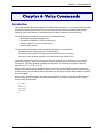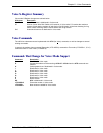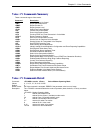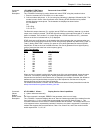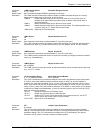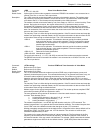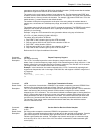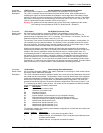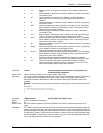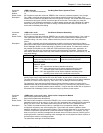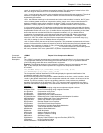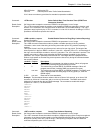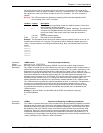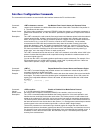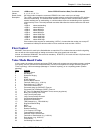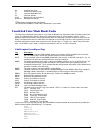
Chapter 6 – Voice Commands
SocketModem Global MT5634SMI Developer’s Guide 52
3 LT Modem off-hook. Local phone connected to Telco. Modem connected to
Telco.
4 S Internal speaker connected to the modem. Modem is on-hook. Local phone
connected to Telco.
5 ST Internal speaker connected to Telco. Modem is off-hook. Modem is
connected to Telco. Local phone provided with power to detect hook
condition.
6 M Internal microphone connected to modem. Modem is on-hook. Local phone
connected to Telco.
7 MST Internal microphone and internal speaker connected to Telco. Squelching
active. Modem is off-hook, and connected to Telco. Local phone provided
with power to detect hook condition.
8 S1 External speaker connected to modem. Modem is on-hook. Local phone
connected to Telco.
9 S1T External speaker connected to Telco. Modem is off-hook and connected to
Telco. Local phone provided with power to detect hook condition.
10 MS1T Internal microphone and external speaker connected to Telco. Squelching
active. Modem is off-hook, and connected to Telco. Local phone provided
with power to detect hook condition.
11 M1 External microphone connected to modem. Modem is off-hook. Local phone
connected to Telco.
12 M1ST External microphone and internal speaker connected to Telco. Squelching
active. Modem is off-hook, and connected to Telco.
Local phone provided with power to detect hook condition.
13 M1S1T External microphone and external speaker connected to Telco. Squelching
active. Modem is off-hook, and connected to Telco. Local phone provided
with power to detect hook condition.
14 H External microphone and speaker combination (handset or headset)
connected to modem. Modem is off-hook. Local phone connected to Telco.
15 HT External microphone and speaker combination (headset or handset)
connected to modem. Modem is off hook, and connected to Telco. Local
phone provided with power to detect hook condition.
Command: +VLS=? Identify Analog Source/Destination Configuration and
Event Reporting Capabilities
Result Codes: <label>,<devices>,trasmit event>,<receive event>,<idle event>
Description: The +VLS=? command displays the modem's current source and destination device information for
the analog data to be transmitted. Refer to the +VLS= <label> command for label code and
description information. Note that the +VEM command contains more information about event
reporting.
Example: In the lines below, the modem reports that it supports only a Telco line at Service Level
C.
AT+VLS=?
0,"",0A0001000,0E601800,1A803840
1, "T", 0A0001000,0E601800,1A803840
OK
Command: +VRA=<interval> Set Ring Back Goes Away Timer
Values: 0–50 (in 0.10 second increments)
Default: 50
Result Codes: OK if the modem accepts the command; ERROR if the <interval> parameter entered is out of
range.
Description: The +VRA= command sets the amount of time the modem will wait between Ringbacks before the
modem can assume that the remote device has gone off-hook. This command does not effect the
Quiet Answer @ dial modifier; the +VRA command functions the same as the @ entered at the end
of a dial string. Entering +VRA=0 forces the modem to return the OK result code immediately after
the first Ring Back. The parameter <interval> refers to the silence interval length between the end
of one ring interval and the start of the next ring interval.



